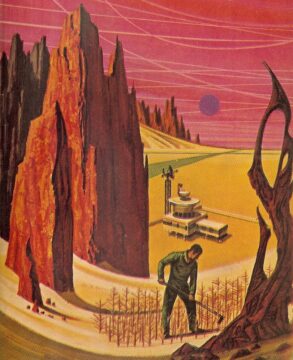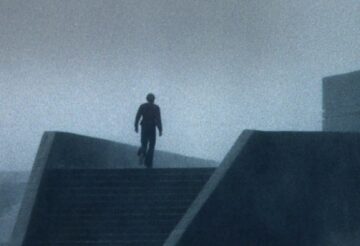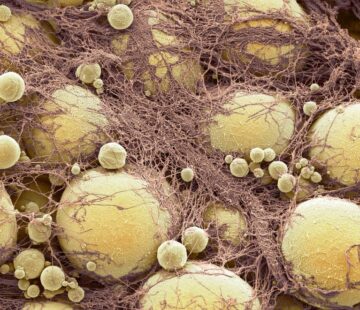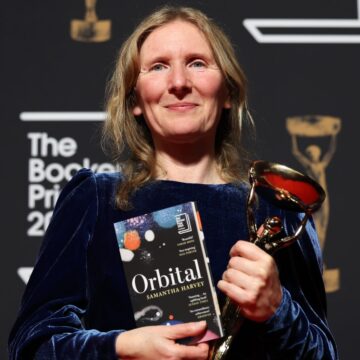Jonathan Lethem at The Paris Review:
 Dick’s use of the name New Israel in Martian Time-Slip is pretty stock. Dick traveled beyond North America only once, to a conference in Metz, France, where he delivered a legendary speech titled “If You Find This World Bad, You Should See Some of the Others”—baffling his French fans by opening an early window into the mystical, visionary search that would preoccupy him for the remainder of his life. Then he went home to Orange County, California. His impression of Israel may essentially be derived from Leon Uris’s Exodus, or from some other heroic fifties representation; he principally employs the Israelis in Martian Time-Slip as an anonymous and implacable counterpoint to the abject ineptitude of the U.S. colonists—to highlight the haplessness of their attempts to farm and irrigate the harsh Martian desertscape. As in the excerpt above, the Israelis present a mirror for shame. This matches, of course, a typical midcentury U.S. liberal’s reaction formation, after the discovery of the German and Polish death camps: the Jew as shame trigger, with the survivors idealized for their resilience and strength.
Dick’s use of the name New Israel in Martian Time-Slip is pretty stock. Dick traveled beyond North America only once, to a conference in Metz, France, where he delivered a legendary speech titled “If You Find This World Bad, You Should See Some of the Others”—baffling his French fans by opening an early window into the mystical, visionary search that would preoccupy him for the remainder of his life. Then he went home to Orange County, California. His impression of Israel may essentially be derived from Leon Uris’s Exodus, or from some other heroic fifties representation; he principally employs the Israelis in Martian Time-Slip as an anonymous and implacable counterpoint to the abject ineptitude of the U.S. colonists—to highlight the haplessness of their attempts to farm and irrigate the harsh Martian desertscape. As in the excerpt above, the Israelis present a mirror for shame. This matches, of course, a typical midcentury U.S. liberal’s reaction formation, after the discovery of the German and Polish death camps: the Jew as shame trigger, with the survivors idealized for their resilience and strength.
More here.
Enjoying the content on 3QD? Help keep us going by donating now.

 The year is 1617. His name is Johannes Kepler (December 27, 1571–November 15, 1630) — perhaps the unluckiest man in the world, perhaps the greatest scientist who ever lived. He inhabits a world in which God is mightier than nature, the Devil realer and more omnipresent than gravity. All around him, people believe that the sun revolves around the Earth every twenty-four hours, set into perfect circular motion by an omnipotent creator; the few who dare support the tendentious idea that the Earth rotates around its axis while revolving around the sun believe that it moves along a perfectly circular orbit. Kepler would disprove both beliefs, coin the word orbit, and quarry the marble out of which classical physics would be sculpted. He would be the first astronomer to develop a scientific method of predicting eclipses and the first to link mathematical astronomy to material reality — the first astrophysicist — by demonstrating that physical forces move the heavenly bodies in calculable ellipses. All of this he would accomplish while drawing horoscopes, espousing the spontaneous creation of new animal species rising from bogs and oozing from tree bark, and believing the Earth itself to be an ensouled body that has digestion, that suffers illness, that inhales and exhales like a living organism.
The year is 1617. His name is Johannes Kepler (December 27, 1571–November 15, 1630) — perhaps the unluckiest man in the world, perhaps the greatest scientist who ever lived. He inhabits a world in which God is mightier than nature, the Devil realer and more omnipresent than gravity. All around him, people believe that the sun revolves around the Earth every twenty-four hours, set into perfect circular motion by an omnipotent creator; the few who dare support the tendentious idea that the Earth rotates around its axis while revolving around the sun believe that it moves along a perfectly circular orbit. Kepler would disprove both beliefs, coin the word orbit, and quarry the marble out of which classical physics would be sculpted. He would be the first astronomer to develop a scientific method of predicting eclipses and the first to link mathematical astronomy to material reality — the first astrophysicist — by demonstrating that physical forces move the heavenly bodies in calculable ellipses. All of this he would accomplish while drawing horoscopes, espousing the spontaneous creation of new animal species rising from bogs and oozing from tree bark, and believing the Earth itself to be an ensouled body that has digestion, that suffers illness, that inhales and exhales like a living organism. The vampire as it’s developed over the past century of popular culture, from Dracula onward, is different from the folkloric eastern European creature—a gloaming animal of the night, subaltern to humanity—though elements have obviously been preserved. Stoker’s titular count is arguably as super-human as he is monstrous. “I am Dracula; and I bid you welcome,” the Transylvanian count tells Jonathan Harker, the English solicitor organizing the sale of London real estate to the undead aristocrat. “Come in, the night air is chill, and you must need to eat and rest.” Where the skeletons in that Bulgarian basement were of people understood (fairly or not) by their neighbors as feral, rabid, and wild, Dracula is urbane and sophisticated, cosmopolitan and sexy.
The vampire as it’s developed over the past century of popular culture, from Dracula onward, is different from the folkloric eastern European creature—a gloaming animal of the night, subaltern to humanity—though elements have obviously been preserved. Stoker’s titular count is arguably as super-human as he is monstrous. “I am Dracula; and I bid you welcome,” the Transylvanian count tells Jonathan Harker, the English solicitor organizing the sale of London real estate to the undead aristocrat. “Come in, the night air is chill, and you must need to eat and rest.” Where the skeletons in that Bulgarian basement were of people understood (fairly or not) by their neighbors as feral, rabid, and wild, Dracula is urbane and sophisticated, cosmopolitan and sexy. The Sun rises every day. Water boils at 100°C. Apples fall to the ground. We live in a world in which objects behave the same given the same circumstances. We can imagine living in a different world: a world that constantly changes, a world in which the Sun does not rise every day, a world in which water one day boils at 50°C, and at 120°C another day, a world in which apples sometimes fall from trees and sometimes rise into the sky. Only because we live in a world that displays stable regularities are we able to reliably shape our environment and plan our lives.
The Sun rises every day. Water boils at 100°C. Apples fall to the ground. We live in a world in which objects behave the same given the same circumstances. We can imagine living in a different world: a world that constantly changes, a world in which the Sun does not rise every day, a world in which water one day boils at 50°C, and at 120°C another day, a world in which apples sometimes fall from trees and sometimes rise into the sky. Only because we live in a world that displays stable regularities are we able to reliably shape our environment and plan our lives. Dr. Adam Rodman, an expert in internal medicine at Beth Israel Deaconess Medical Center in Boston, confidently expected that chatbots built to use artificial intelligence would help doctors diagnose illnesses.
Dr. Adam Rodman, an expert in internal medicine at Beth Israel Deaconess Medical Center in Boston, confidently expected that chatbots built to use artificial intelligence would help doctors diagnose illnesses. Poems written by AI are preferred to those written by humans, according to a new study. The non-expert poetry readers who participated were more likely to judge AI-generated poems as being written by humans than those actually written by humans. The
Poems written by AI are preferred to those written by humans, according to a new study. The non-expert poetry readers who participated were more likely to judge AI-generated poems as being written by humans than those actually written by humans. The  Even after drastic weight loss, the body’s fat cells carry the ‘memory’ of obesity, research
Even after drastic weight loss, the body’s fat cells carry the ‘memory’ of obesity, research On June 14 of this year, Delhi Lieutenant Governor V.K. Saxena authorized the prosecution of author Arundhati Roy and Kashmir-based academic Sheikh Showkat Hussain for speeches they made in 2010 about the disputed territory of Kashmir. Put otherwise, the Indian government charged a world-famous author and activist under a stringent antiterrorism law, the Unlawful Activities Prevention Act (UAPA).
On June 14 of this year, Delhi Lieutenant Governor V.K. Saxena authorized the prosecution of author Arundhati Roy and Kashmir-based academic Sheikh Showkat Hussain for speeches they made in 2010 about the disputed territory of Kashmir. Put otherwise, the Indian government charged a world-famous author and activist under a stringent antiterrorism law, the Unlawful Activities Prevention Act (UAPA). The Science Museum in Britain holds numerous items associated with the Nobel Prize-winning mathematical physicist Sir Roger Penrose: books on consciousness and the nature of space and time; a set of
The Science Museum in Britain holds numerous items associated with the Nobel Prize-winning mathematical physicist Sir Roger Penrose: books on consciousness and the nature of space and time; a set of  M
M Orbital, which was published last November and is now available in paperback, was the highest-selling book of the shortlist in the run-up to the winner announcement, with
Orbital, which was published last November and is now available in paperback, was the highest-selling book of the shortlist in the run-up to the winner announcement, with